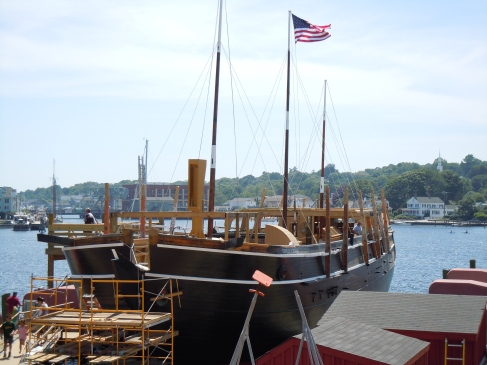In our experience, maritime museums worldwide and museums with historical ships (mostly tall ships) as their primary exhibit, charge at least US$ 15 (or the local currency equivalent) as entrance fee. It has been the case for the ‘Rickmer Rickmers’ windjammer and one of the ‘Seven Swans’ vessel ‘San Cap Diego’ in Hamburg, the full-size replica of the tall ship ‘Bounty’(which we had the fortunate opportunity to visit in Plymouth, MA in the summer of 2012; the vessel sank – with loss of life – a few short months later during hurricane Sandy.)
Recently, we were visiting the fully restored whaleship ‘Charles W Morgan’ at the Mystique Seaport in Mystique, CT. The vessel is the oldest and only surviving whaleship in the world – originally built in 1841 in New Bedford, Massachusetts), and has been exceptionally rebuilt with great attention to historical detail not only in terms of getting rebuilt accurately but also in terms of the means, techniques and tools utilized to rebuild the vessel. It has been stated that the cost of rebuilding the vessel has been in the US$7 million range, no doubt every dollar being very worthily spent.
We admit that we are not experts at museum economics, and for the purposes of this discussion with ignore positive externalities, the value of maintaining maritime traditions and old workmanship skills through generations, and the importance of donations and fund-raising for supporting such projects, but we were tempted running back of the envelop calculations:
Assuming that the attraction originates 100 incremental tickets and memberships per diem – and ignoring any additional collateral revenue that may be generated indirectly for the museum, it will take about nine years for the investment payback. Not a great result if the only benchmark for the ‘investment’ was purely financial. There are investment opportunities elsewhere that can have a shorter payback period.
It has been posted to the museum’s website that since 1941 when she joined the Mystique Museum that twenty million visitors walked on her deck, which makes our assumption of about 100 incremental tickets / memberships rather reasonable.
For those active in today’s shipping markets, it’s well known that the market is in a multi-year trough. Despite the weakness of freight rates, still many vessels are getting ordered, to the surprise of many. Running the same payback yardstick for an asset class like the capesize vessels, a newbuilding cost ca. US$ 40 mil and the vessel has been generating (generously) US$ 4,000 daily operating profit. Resuming that the freight market will remain such in the future, the payback period for a newbuilding capesize vessel (unlevered basis) will be more than twenty-five years…. Almost triple that of a model ship in a museum…
Now that freight rates are expected to be low for the foreseeable future and the demolition market also at a trough (with so many vessels to be scrapped after all, pricing has to come down), it has occurred to us that possibly converting older vessels to museum pieces and anchoring a vintage vessel at each port may be a viable way of reducing excessive tonnage from the market. Aye, with so many vessels idle in the market, possibly we could just convert even modern tonnage to museum pieces!
This maybe a new model for shipping to improve the market dynamics and the economics, we are sad to say.
© 2013 Basil M Karatzas

No comments:
Post a Comment